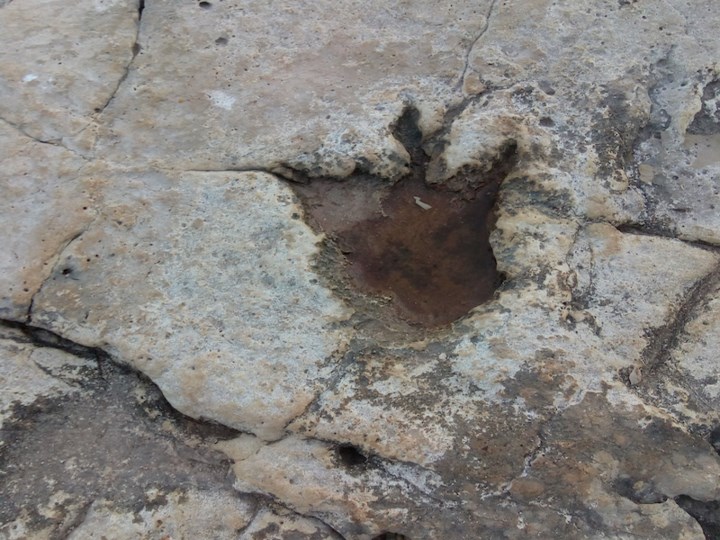Dinosaurs are probably not the first thing that comes to your mind when you think of Istria :) However, these
“dire lizards” (which is a direct translation of their Latin name) also
lived on the territory of Croatia, and
Istria has
one of the richest sites of their remains. Istria was inhabited by this incredible species of mostly giants that once dominated Earth, in the
Cretaceous period (80-140 million years ago). With this said, it is clear, that even though not widely known, these findings are definitely part of an important geological & paleontological heritage of Istria and Croatia.
The
first traces of dinosaurs in Istria were
found in 1925 by the
Austrian Industrialist Bachofen-Echt, on the
Veli Brijun Island. It was the footprint of an Iguanodon genus. Over the next decades, footprints were
found in several places: on the
peninsula Marlera near Medulin and on the
nearby island of Levan. Traces were found also on the small island of Fenoliga and in a small bay in Premantura. The probability of the preservation of footprints is quite exceptional, so that fossil tracks of dinosaurs are relatively rare and thus quite valuable.
The greatest discovery followed in 1992 when
Dario Boscarolli, a diver from Monfalcone,
accidentally discovered bones on the seabed near Bale. It is the first and so far only discovery of dinosaur bones in the entire Mediterranean, and they are estimated to be 150-200 million years old. The discovered bones speak of the existence of
at least 10 species of dinosaurs. One of them is the Brachiosaurus, a herbivore, one of the largest that existed on earth, whose body length was around 20-25 m, with only the neck being about 10 m long. For this reason, and due to its abundance, the Bale finding got included in the World list of paleontological sites.
Therefore it is of utmost importance to preserve these important findings, and luckily this is improving from year to year.
Places you can visit to learn more about dinosaurs in Istria:
Dinosaurs in Istria Exhibition - Bale (close to Rovinj): When some bones were found on the sea bed in Bale in 1992 nobody realised how important the discovery really was. It was a huge discovery. The bones retrieved from the sea were in fact dinosaur bones. It has been estimated that at least 10 dinosaur species lived in this area. One of them is the Brachiosaurus, one of the largest dinosaurs ever to roam the earth whose weight reached 30 tons and could grow to be up to 25 meters long. This
discovery put Bale on the World List of Paleontological Sites. Bale's site, as far as it is known, is
the only find in the world that has dinosaur remains under the sea. It is believed that some of the bones are 200 million years old.
So, make sure you visit Bale and the MMC “Ulika” whose showcases encompass the bones of these huge animals, touch the footprints and remains of these remarkable creatures that used to rule the world.
Path on Cape Kamenjak - abou
t 90 million years ago, this was also the home of dinosaurs. The only thing that is left from that time, are the dinosaurs´ footprints in 2 separate locations - one on Cape Grakalovac (not far from Pinizula Bay) and the other on the islet of Fenoliga, where over a 100 of footprints of sauropods and theropods have been preserved. Enjoy your time on this beautiful peninsula walking or cycling down the 600m long educational & recreational Dinosaur path, enriched by the silence of untouched nature and scents of herbs :)
 Brijuni Islands - Promenade of Dinosaurs
Brijuni Islands - Promenade of Dinosaurs – Being one of the most attractive tourist destinations in Croatia already - we would like to give you one more reason to visit this wonderful archipelago off Pula – discover
the Promenade of Dinosaurs, where around
200 dinosaur footprints on 4 different localities were found, up to
117 million years old. Based on the length of the footprints, the length of the dinosaurs has been estimated (from 3 to 15 m). It needs to be pointed out, that the dimensions of the "Croatian" dinosaurs were somewhat smaller than their contemporary relatives. This fact proves the thesis that large specimen become smaller in isolated areas (like islands). The footprints indicate the species of theropods, iguanodontids, sauropods (2 and 4 legged herbivorous / carnivorous dinosaurs
Dinopark - a stroll with the giants: At the
Dinopark Funtana you will go through
various parts of the world, through many periods and will be introduced to more than thirty different dinosaurs to get a wider and more complete picture of these magnificent creatures. You can experience them by walking through the park in a beautiful natural environment. Their 1.5km long wooden trail is partly in the forest, and partly outdoors.
Discover prehistoric dinosaur traces in Istria by sea – another (adventurous) way to trace the dinosaurs in Istria is by the sea – whether you hire a boat or join one of the numerous excursions from Pula, Rovinj and other places along the southwestern coast of Istria – as many of the dinosaur findings are located on seaside rock formations, so they are convenient to seen during your sea adventure. Get a glimpse of the sauropod or theropod dinosaurs´ traces at the Golden Cliffs near Pula, Fenoliga Island (off the coast of Cape Kamenjak), Cape Gustinja (only a few kilometers from Rovinj) and the Brijuni Archipelago.
So, while staying in one of our wonderful
villas with pool in Istria, you can go back in time by discovering the paths of these ancient magnificent giant inhabitants of Istria :)
Natalie Sipak
08.05.2019

 MY ISTRIA GUIDE
MY ISTRIA GUIDE

